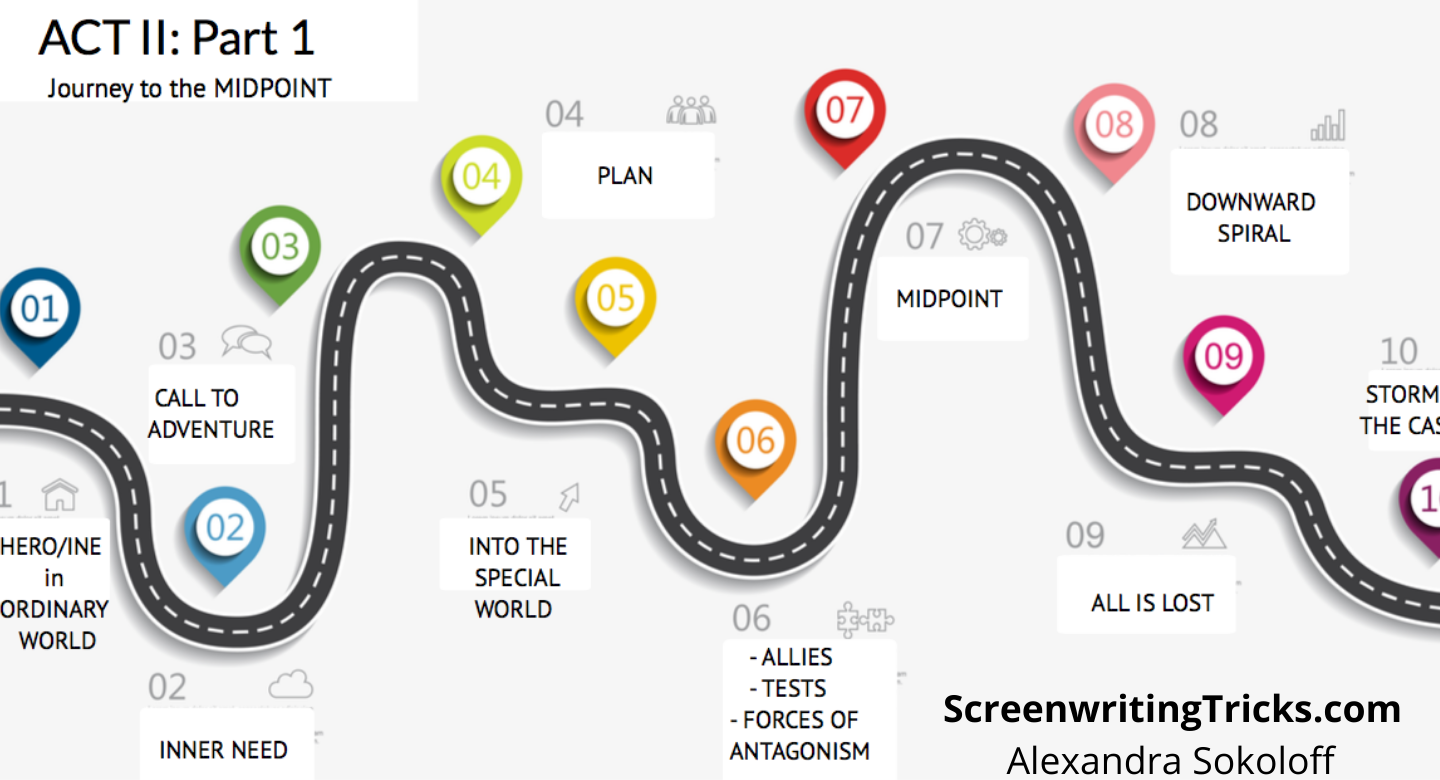Yesterday we talked about general characteristics of a MIDPOINT. Now let’s look at some examples.
A favorite MIDPOINT of mine (in a masochistic kind of way) is in Brian DePalma’s The Untouchables. It’s also a great example of how a main character’s PLAN and MAIN STORY ACTION can lead up to a devastating MIDPOINT REVERSAL.
Young FBI agent Eliot Ness (Kevin Costner) is assigned to bring down mobster Al Capone. So far no one in law enforcement or government has been able to pin Capone to any of his heinous crimes; he keeps too much distance between himself and the actual killings, hijackings, extortions, etc. One of Ness’ Untouchable team, a FBI accountant, proposes that the team gather evidence and nail Capone on federal tax evasion. It’s not sexy, but the penalty is up to 25 years in prison. (As you might know, this PLAN is historically accurate: Al Capone was actually finally charged and imprisoned on the charge of tax evasion.)
So the PLAN and CENTRAL ACTION of the story becomes to locate one of Capone’s bookkeepers, take him into custody and force him to testify against Capone. Which they do. (With plenty of action sequences, of course.) It looks like they’re WINNING (a key characteristic of the first half of Act II).
So as we approach the MIDPOINT, Ness’s team has the bookkeeper in custody, the trial is set, and Ness’s men are escorting the bookkeeper to court.
But the movie is only half over. So of course, as very often happens at the Midpoint, the plan FAILS. In a suspenseful and emotional wrenching MIDPOINT CLIMAX, Ness’s accountant teammate, whom we have come to love, escorts the bookkeeper into the courthouse elevator to take him up to the courtroom. As the doors close, we see the police guard is actually one of Capone’s men. (Cue ominous music…)
Ness and his other teammate (a criminally hot Andy Garcia), realize that something’s wrong and race up (down?) the stairs to catch the elevator, but arrive to find a bloodbath – both accountants brutally murdered, and the word TOUCHABLE painted on the elevator in blood as a taunt.
So the plan is totally foiled – they have no witness and no more case. It’s a great midpoint reversal, because we – and Ness himself – have no idea what the team is going to be able to do next (and also Ness is so emotionally devastated by the loss of his teammate that he begins to do reckless things.).Not only does the murder of the two accountants (Capone’s and Ness’s) completely annihilate Ness’s PLAN), but the murder of Ness’s teammate makes the stakes deeply personal.
But a Midpoint doesn’t have to be a huge action scene. Another interesting and tonally very different Midpoint happens in Raiders of the Lost Ark. Some people would dispute me on this one (and people argue about the exact midpoint of movies all the time), but I say the Midpoint is the scene that occurs exactly 60 minutes into the film, in which, having determined that the Nazis are digging in the wrong place in the archeological site, Indy goes down into that chamber with the pendant and a staff of the proper height, and uses the crystal in the pendant to pinpoint the exact location of the Ark.
This scene is quiet, and involves only one person, but it’s mystically powerful – note the use of light and the religious quality of the music… and Indy is decked out in robes almost like, well, Moses. Staff and all. Indy stands like God over the miniature of the temple city, and the beam of light comes through the crystal like light from heaven. It’s all a foreshadowing of the final climax, in which God intervenes in much the same way. Very effective, with lots of subliminal manipulation going on. And of course, at the end of the scene, Indy has the information he needs to retrieve the Ark. I would also point out that the Midpoint is often some kind of mirror image of the final climax; it’s an interesting device to use, and you may find yourself using it without even being aware of it.
(I will concede that in Raiders, you could call the Midpoint a two-parter: Indy’s discovery that Marion is still alive is a big twist. But personally I think that scene is part of the next sequence).
Another very different kind of midpoint occurs in Silence of the Lambs: the iconic “Quid Pro Quo” scene between Clarice and Lecter, in which she bargains personal information to get Lecter’s insights into the case. Clarice is on a time clock, here, because Catherine Martin has been kidnapped and Clarice knows they have only three days before Buffalo Bill kills her. Clarice goes in at first to offer Lecter what she knows he desires most (because he has STATED his desire, clearly and early on) – a transfer to a Federal prison, away from Dr. Chilton and with a view. Clarice has a file with that offer from Senator Martin – she says – but in reality the offer is a total fake. We don’t know this at the time, but it has been cleverly PLANTED that it’s impossible to fool Lecter (Crawford sends Clarice in to the first interview without telling her what the real purpose is so that Lecter won’t be able to read her). But Clarice has learned and grown enough to fool Lecter – and there’s a great payoff when Lecter later acknowledges that fact.
The deal is not enough for Lecter, though – he demands that Clarice do exactly what her boss, Crawford, has warned her never to do: he wants her to swap personal information for clues – a classic deal with the devil game.
After Clarice confesses painful secrets, Lecter gives her the clue she’s been digging for – to search for Buffalo Bill through the sex reassignment clinics. And as is so often the case, there is a second climax within the midpoint – the film cuts to the killer in his basement, standing over the pit making a terrified Catherine put lotion on her skin – it’s a horrifying curtain and drives home the stakes. (Each climax in SOTL is a one-two punch – screen the movie again and see what I mean!).
I recently reread Harlan Coben’s The Woods, which employs a great technique to craft an explosive Midpoint: the book has an A story and a B story (well, really, with Coben it’s always about sixteen different threads of each plot intricately interwoven, but two main plots). In the B story, the protagonist is prosecuting two frat boys who raped a stripper at a frat party, and at the Midpoint is the main courtroom confrontation of that plot. The storyline continues, but now it becomes subordinate (and of course interconnected to) to the building A plot. This very emotional climaxing of the B plot at the midpoint is a terrifically effective structure technique that is great to have in your story structure toolbox.
In Sense and Sensibility, the Midpoint is the emotionally wrenching scene in which Lucy Steele reveals to Elinor that she has been secretly engaged to Edward Ferrars for five years. We are so committed to Edward and Elinor’s love that we are as devastated as Elinor is, and just as shocked that Edward would have lied to her. The Midpoint is even more wrenching because Elinor’s sister Marianne has also just been abandoned by her love interest. It’s a double-punch to the gut.
In Notting Hill, Julia Roberts has asked Hugh Grant up to her hotel suite for the first time, and Hugh walks in to find that Julia’s movie star boyfriend, Alec Baldwin, whom Hugh knew nothing about, is already there with her. We know that Hugh’s GHOST is that his ex-wife left him for a man who looked just like Harrison Ford (Alec is pretty close!), and to add to this blow, Alec mistakes Hugh for a room-service waiter and tips him, asking him to clean up while he takes Julia into the bedroom. Total emotional annihilation.
In a romance, the Midpoint is very often sexual or emotional. But the Midpoint can often be one of the most memorable visual SETPIECES of the story, just to further drive its importance home.
Note that the Midpoint is not necessarily just one scene; it can be a double punch as I just pointed out about Sense And Sensibility, and it can also be a progression of scenes and revelations that include a climactic scene, a complete change of location, a major revelation, a major reversal, a cliffhanger – all or any combination of the above.
And of course I go through many, many more examples in the workbooks, STEALING HOLLYWOOD and WRITING LOVE!
If you’re struggling with your Midpoint, take a look at three Midpoints from your Master List to get inspired!
- Alex





